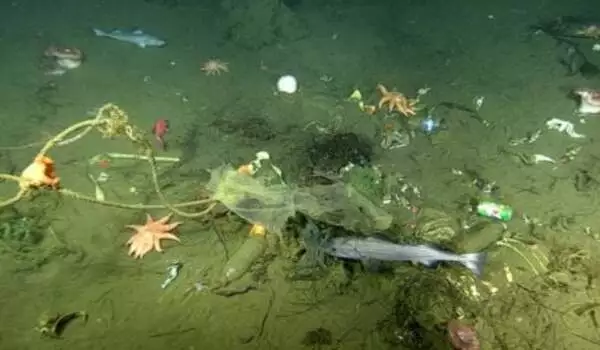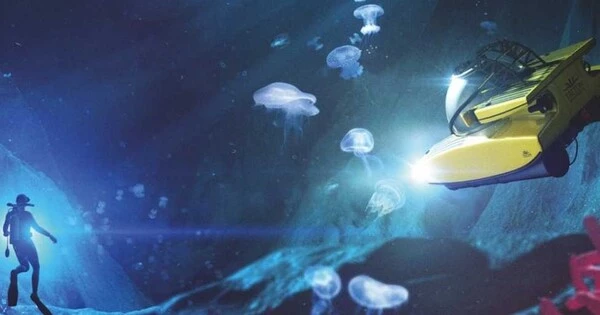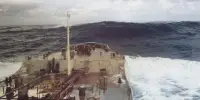The world’s oceans are a vast habitat for countless creatures that live on the seafloor and settle, spawn, dig, or feed. They also have an impact on the shape of the ocean floor. So far, little has been discovered about how this occurs. Geoscientists, biologists, and oceanographers investigated crater-like depressions on the North Sea seafloor in an interdisciplinary study. They were able to demonstrate that these are directly related to the habitats of porpoises and sand eels, providing a conclusive explanation for the importance of vertebrates in shaping the seafloor for the first time.
The North Sea seafloor is dotted with thousands of pockmarks, which are crater-like depressions in the sediment. There are probably millions of them in the world’s ocean. According to common scientific belief, they are formed by fluid discharge, such as the greenhouse gas methane or groundwater. The majority of these pockmarks continue to perplex researchers today, as many cannot be explained by fluid seepage.
“Our findings show for the first time that these depressions are caused by the habitat and behavior of porpoises and sand eels, rather than rising fluids,” says Dr Jens Schneider von Deimling, lead author of the current study and geoscientist at Kiel University.
“Our high-resolution data provide a new interpretation for the formation of tens of thousands of pits on the North Sea seafloor, and we predict that the underlying mechanisms occur globally, but have been overseen until now,” Schneider von Deimling said.
Schneider von Deimling and colleagues from the Alfred Wegener Institute, the Helmholtz Centre for Polar and Marine Research (AWI), the University of Veterinary Medicine Hannover Foundation (TiHo), and the Leibniz Institute for Baltic Sea Research Warnemünde (IOW) examined the seafloor in the North Sea off Heligoland to centimeter precision for the study. In addition, they examined the behavior of vertebrates such as porpoises.
Our high-resolution data provide a new interpretation for the formation of tens of thousands of pits on the North Sea seafloor, and we predict that the underlying mechanisms occur globally, but have been overseen until now.
Schneider von Deimling
Vertebrates leave pits in the seabed of the North Sea
Most of the depressions in the seafloor in the German Bight, the team suspects, are created by porpoises and other animals in search of food, and then scoured out by bottom currents. The sand eel, a small eel-like fish that spends most of the year buried in shallow sediments, plays a key role in this process. Sand eels are not only popular with the fishing industry, but are also consumed in large quantities by porpoises.
“From analyses of the stomach contents of stranded porpoises, we know that sand eels are an important food source for the North Sea population,” says Dr. Anita Gilles of the TiHo-Institute for Terrestrial and Aquatic Wildlife Research (ITAW), who has long studied the biology of marine mammals. In their study, the researchers showed that marine mammals leave pits in the seafloor when they hunt for buried sand eels. Although these pits resemble the familiar pockmarks, they are much shallower.

Advanced multibeam echosounder technology provides information on pit condition
The detection of pits has only recently become possible thanks to modern multibeam echosounder technology, which is taught and practiced extensively at Kiel University. “The formation mechanism of these pits, as we call them, probably also explains the existence of numerous crater-like depressions on the seafloor worldwide, which have been misinterpreted as the result of methane gas leaks,” Schneider von Deimling, a geoscientist, said. The researchers discovered 42458 of these enigmatically shaped, shallow pits with an average depth of only eleven centimeters in the North Sea, which differ in morphology from the more conical craters of the pockmarks.
Schneider von Deimling is vice chairman of the German Hydrographic Society (DHyG) and works in the Kiel Marine Geophysics and Hydroacoustics working group at the Institute of Geosciences and the Kiel Marine Science (KMS) priority research area at Kiel University. He never believed that the depressions in the German Bight were caused by rising fluids, despite his expertise in seafloor mapping, methane gas seepage, and seafloor pockmarks.
“We needed to come up with another hypothesis for the formation.” This allowed us to predict potential porpoise feeding sites, which is where we found the pits – always near sandeel habitats. Our multidisciplinary data analysis has now provided a conclusive explanation for our harbor porpoise pits hypothesis.”
An interdisciplinary approach leads to the harbor porpoise pits hypothesis
The key to the new findings was an interdisciplinary approach that brought together geological studies, geophysical sonar measurements, vertebrate behavior and feeding biology, satellite evaluation, and oceanographic analysis. By precisely analyzing millions of echo-soundings collected by German research vessels, the researchers were able to locate the unusual pits.
“We can now measure the seafloor with centimeter precision and thus find the shallow pits using special echosounding methods.” “We can also look into the seafloor to see if there is free methane gas, for example,” explains AWI researcher Dr Jasper Hoffmann.
The task of analyzing the data collected by research vessels over thousands of nautical miles was enormous. “With modern methods, such structures can be automatically detected and characterized in acoustic data sets, as well as automatically analyzed in large data sets,” says co-author Dr. Jacob Geersen.
From the North Sea into the world: results with far-reaching effects
The research team currently believes that the initial feeding pits serve as a nucleus for scouring and eventually develop into larger pits. This finding also has global implications. The scouring of sediments by vertebrates in the ocean could modulate the seafloor on a global scale and influence benthic ecosystems.
Pits cover 9% of the seafloor in the study area alone. According to preliminary volume estimates, 773369 tons of sediment have been deposited over a 1581 km2 area. This is roughly equivalent to the weight of 500,000 cars. “Our findings have far-reaching geological and biological implications. They can assist in assessing the ecological risks associated with the expansion of renewable energies in the offshore sector, thereby improving marine environmental protection,” Schneider von Deimling concludes.
















